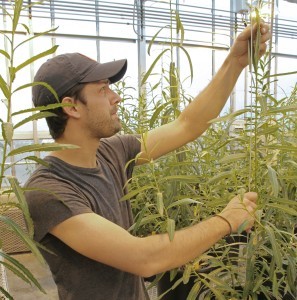Reposted from the SIPS blog Discovery that Connects:

For scientists, an understanding of root morphology is of tremendous importance for agricultural and biofuel crops alike. The measurement of the belowground traits of plants has become increasingly important because of the vital role that root biomass and architecture play in traits like drought tolerance and carbon sequestration. The ability to measure root biomass is useful in plant breeding programs, but is a daunting task that requires washing, filtering, drying, and weighing fine and intricate root tissues. Researchers have used electrical capacitance—the ability of an object to store an electrical charge—to measure root biomass, but this technique had only been shown to work in hydroponically grown plants and had not been extensively tested in soil-grown woody plants grown from cuttings.
As Craig Carlson, a PhD candidate at Cornell University’s College of Agriculture and Life Sciences, explains, “A majority of electroconductivity studies have focused on annual grasses and hydroponic systems. We wanted to develop a cheap, quick method of measuring root biomass in soils.” Carlson works with Dr. Larry Smart, leader of North America’s largest breeding program for shrub willow (Salix spp.), an important biofuel crop. One aspect of their breeding work requires growing up to 400 individual plants in separate pots, and an efficient method to quantify root biomass would allow for rapid selection of individuals with optimal traits to continue breeding. The alternative is to mechanically remove soil to measure root biomass, a method that is both destructive and extremely time consuming.
Despite being initially skeptical that the root electrical capacitance (REC) method would work in soil, Carlson was able to tweak the technique and demonstrate its efficacy in a paper published in a recent issue of Applications in Plant Sciences.
More information:
- Read the complete press release
- Learn more about the Smart research program at Willopedia


